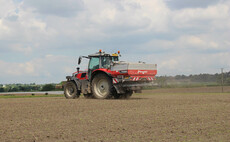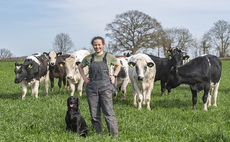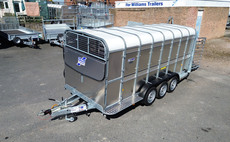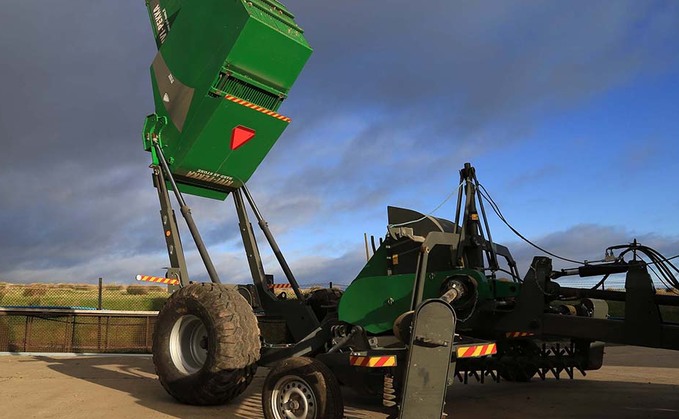
Stone picking is undoubtedly one of the bleakest jobs on any farm, however, mechanical stone pickers can prove a useful way of clearing land without being a back breaking chore. Alex Heath visits a farm employing one such machine.
With a historic policy of filling in hollows, along with having to deal with marginal land, and the opportunity for contracting in the local area, farming business V J Bromley, based near Shrewsbury decided to invest in a stone picker.
The business's Bill Bromley explains the farm's varied stone content, due to the local soil types and min-till practices, has seen an increase in stone coming to the surface in recent years.
He says; "Stone picking is one job no one enjoys, but to protect machinery and establish good crops it is a necessity. We had a contractor come in with a stone picker around three years ago and he did a good job, so we started looking for our own."
Arriving on the farm in 2018, the Finnish-built Kivi Pekka stone picker has been used intermittently, however, Mr Bromley admits the past few seasons post-harvest have not been conducive to high work rates.
"The soil needs to be dry and friable. If there is too much moisture in the soil it does not break up and crumble. We would typically start working through fields after harvest, but the past two seasons have really been too wet in many cases," says Mr Bromley. "That is not to say it will not work, but when it is dry it does a fantastic job of separating the soil out. The conditions must be right and the preparation of the land must be done well."
The farm uses a four-metre pig tail tine harrow to prep the land ahead of the stone picker. "The pig tail tines get the stones onto the surface," explains Mr Bromley. "It is vital most of the stone is in the top inch, as the rotors are not designed to work deep. Instead, they rake the top of the soil profile."
In many instances, Mr Bromley says the farm will make two passes with the cultivator and stone picker, to ensure as much rock is removed as possible.
The farm also takes the stone picker out contracting. He says getting customers to understand how the machine works and the requirements for ground prep are challenging, with some expecting the picker to work into a power harrowed bed. He says; "Power harrowing can work, it loosens the soil up, but too often the packer roll is consolidating the worked ground and that really slows progress."
Mr Bromley says the machine is simple in its build and operation. With drive coming from the tractor's pto, a gearbox splits the power between its two rotors. Shafts from the gearbox transmit the power via five V belts and pulleys to the rotors. In addition, the lifting rotor in the centre is driven by three V belts.
The manufacturer suggests a tractor of 70hp is enough to run the stone picker. Mr Bromley concurs, with his John Deere 6155R more than man enough for the job and running at tick over with a tractor pto speed of 400rpm. He says it consumes very little fuel over a day.
With a working width of four metres, the rotors, equipped with hardened steel tines, rake stones from the full working width and form a windrow in the middle of the machine. Just skimming the floor, the lifting rotor drum scoops up the collected stone. It features bars spaced 25mm apart, much like a riddle bucket. Loose soil passes through the gaps, as do any small stones. The lifting rotor is made up of 18 flexible steel tines which flick the larger stones up and into the hopper.
Mr Bromley says the machine will cope with stones up to 350mm in diameter. The manufacturer offers a flex drum option which allows the distance between the rotor and drum to increase, allowing 500mm diameter stones to pass through, however, this was not opted for by Mr Bromley.
"Our stones are not that large, most of them are brick-end size, so we felt it unnecessary to go with the flex drum. We rarely encounter any stones that are too large to be collected. However, in the future we will have a small buckrake fitted to the front of the tractor and lift them out with that when needed," he says.
"The machine is easy to operate, but it does take some concentration and skill to get the most out of it. The rotors are protected from overload by the belts that drive it. Each field needs some fettling of the depth wheels, so the rotor tines are just skimming the soil. The rotors are then controlled while working by tweaking the individual spool levers.
"Having GPS on the tractor makes the job a lot easier," adds Mr Bromley.
The option to go with a four-metre machine rather than any wider is also a blessing in disguise, says Mr Bromley. "Even at four metres, when going over uneven ground, the rotors can stall. I would not want to go any wider, unless on extremely flat ground. For our land and area, the smallest model is just right."
Other than the odd snapped lifting rotor tine, Mr Bromley comments there is little to go wrong on the machine and it has been reliable so far.
There are three points on the machine where soil is extracted. "When the stones are initially picked up, the lifting rotor is aggressive, throwing the stone and soil at the rear of the lifting drum and into the hopper. Much of the soil is crumbled as it hits the rear of the lifting drum and passes through the drum. The stone and any remaining soil land in the hopper which also features bars for small pieces of material to drop through. When tipping, a slow flow out the back door also allows excess soil to pass through the bottom. There is a small soil hopper at the back of the machine which catches any loose soil and it is surprising how much is in there when the hopper is lowered," says Mr Bromley.
The sample is clean enough in most case to be used for bases of buildings and tracks, adds Mr Bromley.
To increase output and make the most of working windows, Mr Bromley says having a loader that can ferry stone from the picker to the boundary of the field, either to a pile or waiting trailer, is a must. When doing so, he reckons an 18 tonne trailer can be filled in under an hour, with an average working speed of 3kph. He adds his best day on the machines saw just over 10 hectares covered.
Weighing in at 4,300kg empty, Mr Bromley says the stone picker acts like a single axle baler on the road with quite a lot of bounce. In the field, however, he says it is easy to pull, even with the two cubic metre hopper full.
Mr Bromley concludes; "The Stone picker is a useful tool to have in our min-till armoury. Using a tine drill and tined cultivators brings a lot of stone to the surface which can damage machinery and make harvesting the crops difficult. It does a good job when conditions permit, but they need to be just right with the soil crumbling to be effective. With little to go wrong on the picker and the amount of steel in it, it will be staying on our farm for a long time."
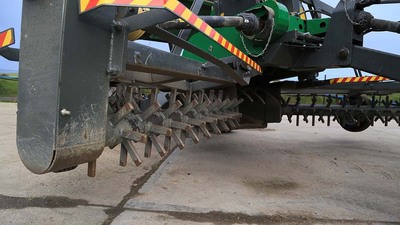
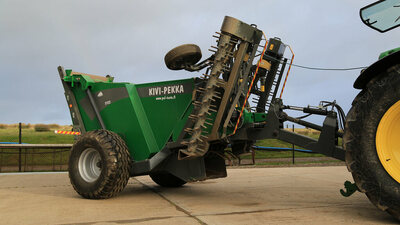
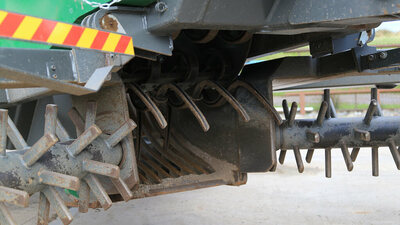
Verdict
Mr Bromley's Kivi Pekka stone picker has definitely made is mark on the farm, turning a chore into an easy task with high work rates.
"Stone picking is one job no one enjoys, but to protect machinery and establish good crops it is a necessity," he says.
"It does a good job when conditions permit, but they need to be just right with the soil crumbling to be effective. With little to go wrong on the picker and the amount of steel in it, it will be staying on our farm for a long time."





















